Bloodhounds: description, feeding and care
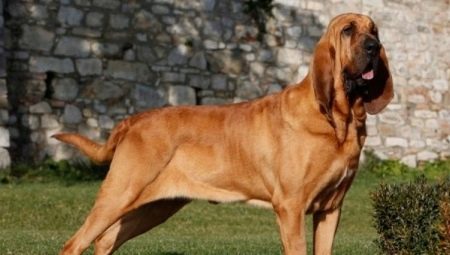
The Bloodhound is a large hound breed with an ancient history dating back centuries. She is known as an excellent tracker, capable of capturing the subtlest odors, so these dogs have served people at all times.
With their folds and "flowing" outlines of the muzzle, they resemble Bassets, but their complexion is completely different - they are taller and more muscular.
Let's talk about the features of this breed, known from time immemorial and in demand to this day all over the world.

History
Bloodhound has other names that sound very majestic: "royal hound", "St. Hubert's dog", "purebred hound" or "blood hound". Obviously, the name of this breed originated from the English "blood", but there is another version linking the name of the breed with its ability to find prey by the smell of blood. It was she who inherited the striking features of the ancient hound, but was improved through selection work.

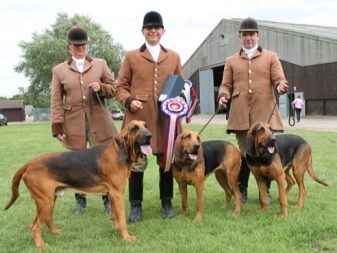
All hounds have a long history, and the first surviving mentions of dogs similar to bloods date back to the 7th century. The breed was crossed with others all the time, and in today's form these dogs were bred in the 13th century in Belgium. The monks of the monastery of St. Hubert bred them to catch poachers who were operating in the forests.
In hunting, their abilities were used to catch a large game: wolf, deer, lynx, which is not within the power of every hunting dog.
It was the representatives of this breed that guarded the palace of the English king Henry VIII.

They caught dangerous criminals, which rendered a great service to the law enforcement officers. Among them is the legendary Nick Carter, who participated in the capture of 600 lawbreakers.
In the 18th century, dogs helped Americans catch escaped slaves. It was difficult to hide from them, because thanks to their phenomenal instinct, the animals found them even a hundred or two kilometers away. But in Russia their popularity was not so high.
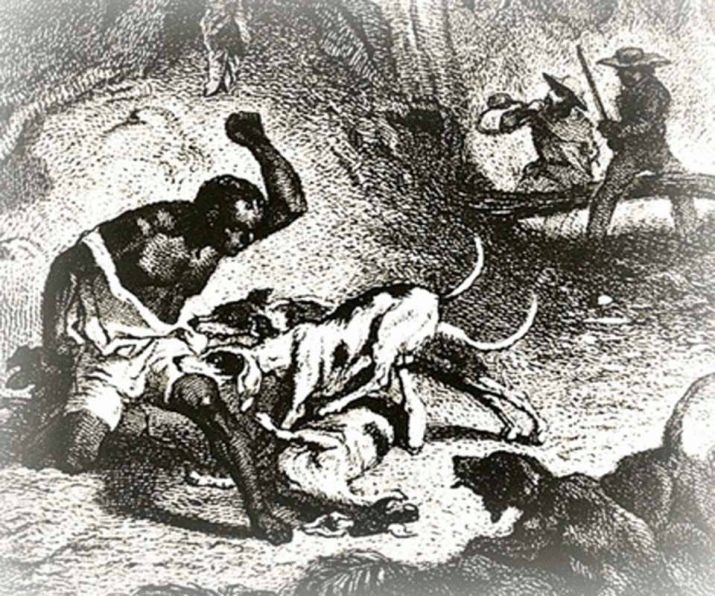
It is known that the Bloods were kept by Peter I and Peter II, then the breed was forgotten, and only in the last century they became interested in it again and began to popularize it in our country. Today, purebred hounds are found all over the world, although this breed is not among the most popular.
Edwin Bru is considered the father of modern bloodhounds. The first breed standard belongs to him. The first Bloodhound Club was established in 1897.
Description of the breed
The characteristic appearance of the Blood does not allow it to be confused with anyone. Let's consider the main features of the appearance of this breed.
Standard
The height at the withers of these dogs is quite large. In males, this indicator is 68 cm, and in females - 62 cm (plus or minus four centimeters). Males weigh in the range of 46-54 kilograms, females 40-48 kilograms. The lifespan of the breed is 12 years... But with good care, this time can increase.

The head of the Bloods is almost square in shape, which is clearly visible when you see the profile of the dog. The folds from the cheeks and forehead hang down quite strongly, especially when the head is lowered, and in males this feature is more noticeable.
The lips of dogs are soft and rather large, while the lower one is smaller. The nose is large, has a black or brown lobe to match the color of the lips.
The jaws of a dog usually have a scissor bite or a straight bite. The eyes range in shades from light brown to dark brown. Redness of the eyelids is quite acceptable, it is easy to notice it due to drooping eyelids.
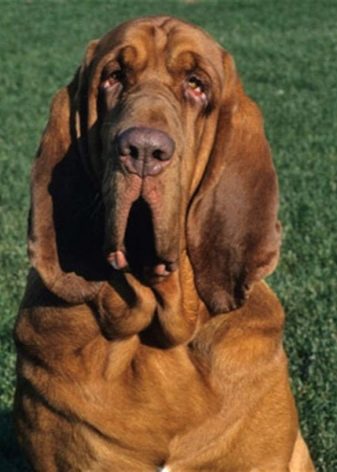
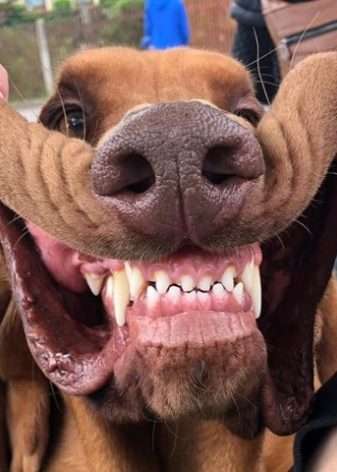
The ears are set quite low, if you feel them, it seems that they are velor - they have such a pleasant surface. Thanks to the strong, but at the same time, sufficiently long neck, Bloodhounds tirelessly sniff the ground, pursuing their prey. The tail of this breed is kept straight at the level of the back, slightly bent.
It is good if the skin wrinkles only on the dog's face, there should not be an abundance of folds in the body area.
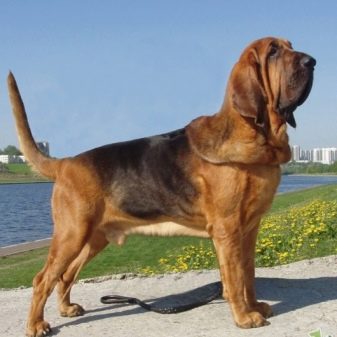
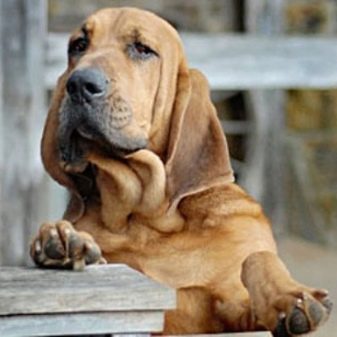
The gait of the dog at the trot has a uniform step, the movements are flexible and light, the dog does not get tired for a long time. The hind feet push off well, the steps are the same for both the front and hind feet. The skin should be well pliable only on the head, on the rest of the body it has good elasticity, but does not lag just as easily. The folds should be in the forehead and cheeks.
Even if they are too large, it does not harm the dog's eyes in any way. The body of the dog is covered with a hard and short coat, due to which the dog tolerates the change of atmospheric phenomena well.
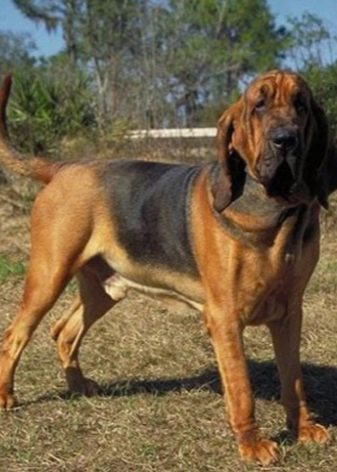
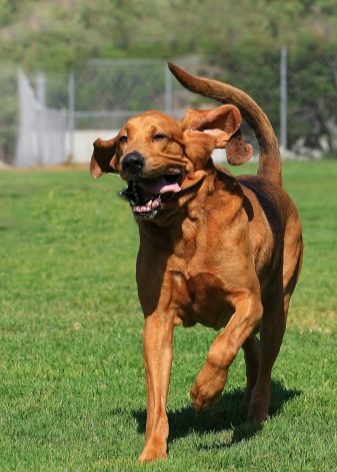
Towards the bottom of the tail, the pile lengthens a little and becomes even tougher, and the softest cover is on the muzzle and ears - there the wool is the softest and most pleasant to the touch.
Color
- Black and red - usually the dark areas on the body of these dogs are located on top. There is an option when black is concentrated in the area of the spine, and the rest of the body has tan marks.
- Brown-red - the color zones are arranged according to the same principle as in the first example.
- Ginger (red) - in this case, it is desirable that the shade changes in the direction of darkening, and not vice versa. Color spots are indistinctly located, light elements are possible in dark places, white marks are undesirable.
As you know, not all dogs are allowed to participate in exhibitions, as they may have disqualifying defects. It all depends on the degree of their severity - for some, this deviation is insignificant, while for others it becomes a reason for withdrawal from the event.
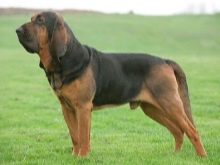
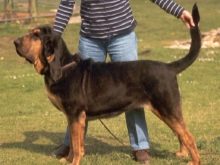
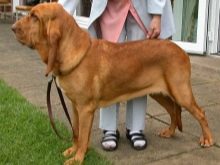
The bloodhound has the following defects:
- deviation from standards;
- unbalanced character (fearfulness or aggressiveness);
- too light iris;
- malocclusion;
- light nose and lips;
- color of the nose that does not match the color;
- white spots in the wrong places, as well as oversized spots of this color.
Advantages and disadvantages
Let's talk about the features of this breed, which can be both positive and negative.
Do your research before deciding if this breed is right for you.
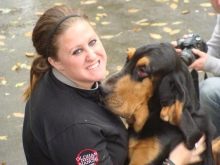
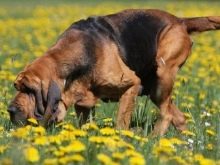
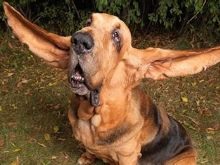
Pros.
- Friendliness. He loves the owner's company, supports his suggestions to play, is always happy to bask in the hands of a person, gladly allows himself to be stroked.
- Excellent scent. Hunters value it most of all, because it is difficult to find such an assistant as a blood. As for everyone else, they can teach the dog tricks to find someone from family members or friends. Of course, there is little practical use for this, but it looks very funny. For example, you can ask the dog to find his dad in a large park and he will instantly take the trail.
- Charm... The cute appearance of these dogs captivates and makes you fall in love at first sight. Blood's eyes are a little melancholy, but very kind. They are able to charm anyone.
- Ease of care... Dogs are naturally healthy enough so they don't need to be "coddled" a lot. Usually excellent health does not let them down.
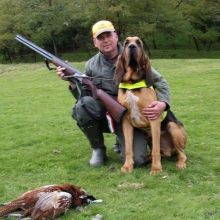
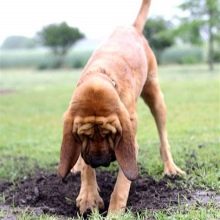
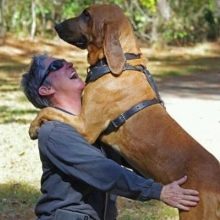
Minuses.
- Lust for the hunt... Owners of hunting dogs face this. Blood may suddenly become interested in a smell and go in search of its source. You have to keep it mostly on a leash.
- Gullibility. It is hardly possible to make guards out of him. The nature of these dogs does not imply protection, they are trusting and kind to all people. Even the trainer finds it difficult to convince the Blood that he should be on his guard with strangers. He will still rejoice at the sight of people and will not be able to harm anyone if necessary.
- The weight. Due to its large size (and the weight of a large dog is comparable to that of a slender girl), a dog can create many problems. Of course, this applies to ill-mannered dogs that the owners did not take care of. His strength is enough to drag the owner on a leash, ignoring his objections.
- Stubbornness. In this, the Bloodhound hunter is similar to his "colleagues" the dachshund and beagle, although in his case it is not so obvious. Raising him as a "good boy" or "girl" is not so easy, you need to show cunning and perseverance. And aggression will not help you, all that can be achieved with this method is to lose the dog's confidence.
Character traits
The kindness of the Bloodhound makes him a favorite not only of adults, but also of children. He has fun in the company of all the household and he is not jealous of other dogs, if they are in the house.
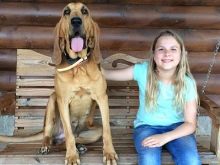
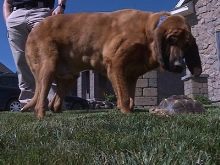
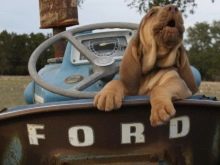
A guest or neighbor may well scratch him behind the ear - the dog will only be glad.
It is impossible to hide anything from this dog, since the scent will lead it to the object of desire, no matter how far you remove the necessary thing.
The owners of a private house will constantly contemplate pits and dug beds, as the dog is always looking for something. We'll have to try to explain to him where you can't dig.
If you love sports, then the dog will gladly support your good endeavors. Blood is happy to go jogging with the owner, while you can put on rollers, he will willingly run with you.
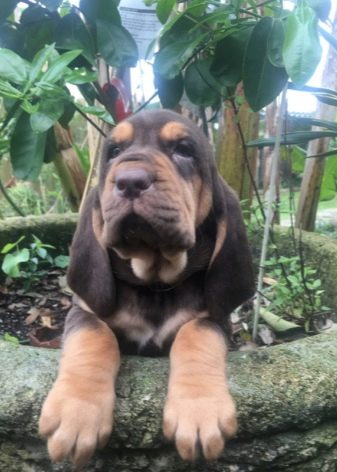
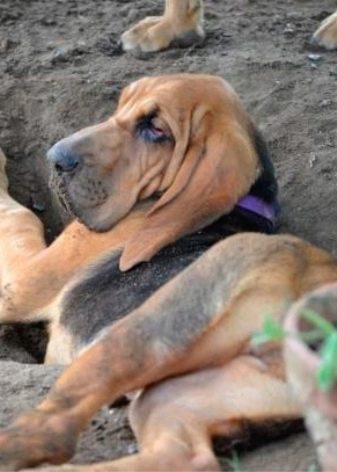
Dogs of this breed love large companies of other people and dogs. For this reason, in large families, a purebred hound feels as comfortable as possible. The reason is in character - these hunting dogs are used to living in packs and constantly communicate with each other and with people. If you can keep several individuals, then they will all be happy. However, other breeds usually do not cause protest from the Blood either.
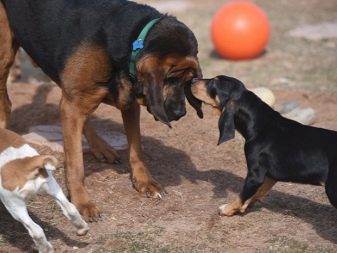
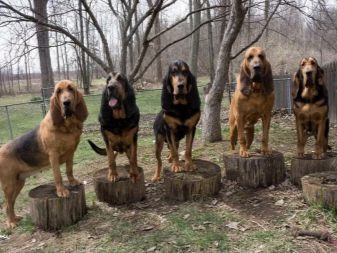
Difficulties with keeping a dog of this breed can arise only because of its vociferousness.
Neighbors will not be delighted with the loud barking of the trumpet, which is characteristic of a bloodhound.
To make such moments happen as rarely as possible, wean the dog from the habit of barking even from puppyhood. And even in this case, there is no guarantee that he will be completely corrected. The dog can burst into barking again in a stressful situation.
By the way, due to the barking of bloodhounds, which are recognized as weak by the guards, able to scare away a person with bad intentions.
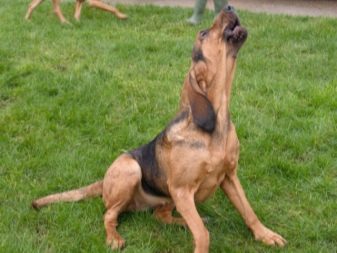
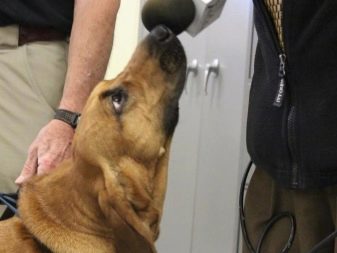
Their bark has a low timbre with a hoarseness and can sound quite intimidating.
Interestingly, the Blood cannot be called a faithful dog of one owner.
Dogs can do well on the commands of the instructor who is hired to teach them. For the same reason, this breed finds good contact with the police officer who hired it. The process of getting used to a new person does not take too much time for the dog.
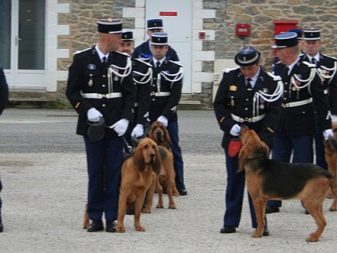
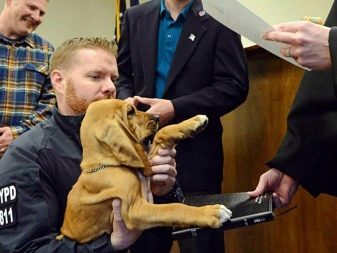
The desire to do the work for which they are intended has a strong influence on the dog, and she happily gets down to business.
Bloodhound is not very suitable for life in a big city with an always busy owner and a lack of contact with nature.
It is very important for him to sniff out, look for and unravel traces all the time. Best of all, representatives of this breed feel themselves living outside the city. There is more room for games, and their barking will not annoy the neighbors living through the wall.
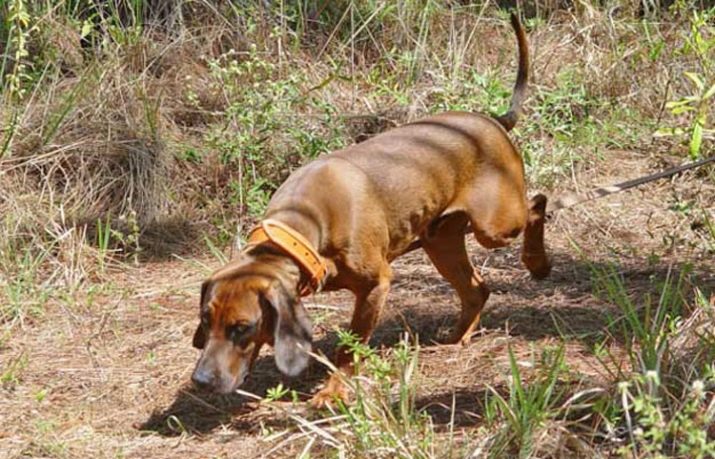
Space is especially important for puppies, as they need enough space to run, play and develop physically.
What to feed?
This breed has a pretty good appetite, like many hunting dogs, they are prone to gluttony, but it is worth remembering the restrictions - the amount of food consumed should not exceed 20% of his body weight.
The food must satisfy the dog's need for all vitamins and minerals. A particularly balanced diet is important for puppies, because what they eat at a young age will determine their health in adulthood. Like all dogs, Bloodhounds are very fond of meat.
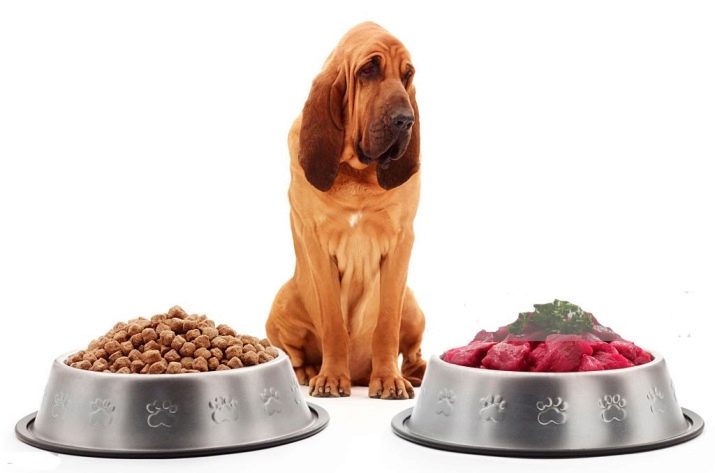
It is better to give low-fat varieties, such as beef, rabbit or poultry, scalding the fillets with boiling water. Fish and eggs are also perfectly acceptable and useful on your four-legged friend's table.
As with other breeds, experts recommend premium food for bloodhounds. They contain all the necessary substances and do not require additional vitamin supplementation, as well as clear planning of the diet on your part.
You can buy various healthy treats in the form of special bones at the pet store.
In addition to the above products it is extremely important to feed your pet with dairy products and cereals, including oatmeal, rice, pearl barley, etc.

It is such a menu that can fill the animal's need for proteins, fats and carbohydrates.
Vegetables and even fruits are also needed for the normal functioning of your pet's body. Knowing the omnivorousness of bloodhounds, it is worth trying to enrich their diet with plant foods, for sure he will like something from the range of fruits you offer.
With this love of food, you can motivate your pet to do commands well. For a piece of delicacy, he is ready for much, even to step on the throat of his pride and become a diligent student.

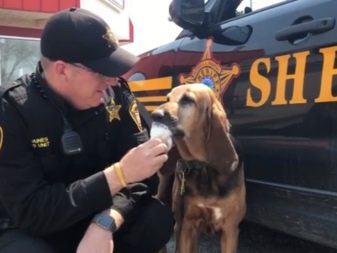
In general, the cunning and flexibility of a person in training these dogs is quite an important point, so for the sake of such an important matter, you can resort to tricks.
How to care?
Keeping a dog of this breed is not so difficult. The wool needs to be combed with a special brush only once a week - at the same time, you will massage the dog, so he will not resist the procedure, and during the shedding period it will have to be done daily.
It is necessary to wash the dog only if there is contamination, usually it already looks great and does not smell.
Drying the fur with a hairdryer is not worth it, blot well enough with a terry towel. So his fur coat will shine and delight you with its healthy and well-groomed appearance.

Ears are a distinctive feature of the Blood. Of course, they serve as its decoration, "highlight", but at the same time, dust often accumulates on them. To keep them from getting dirty, wipe them with a damp cloth several times a month. This will give the dog a more well-groomed appearance and will serve as the prevention of possible ear diseases.
The expressive eyes of the Bloodhound are its weak point, therefore, they need careful care. The eyelids have a special shape that contributes to the accumulation of dirt, because dust easily gets into such folds. This is fraught with the development of inflammation and even conjunctivitis. If you notice dirt or excessive redness when examining your dog, wipe it down with strong tea leaves.
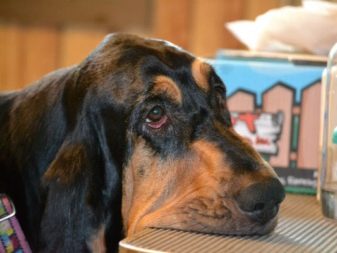
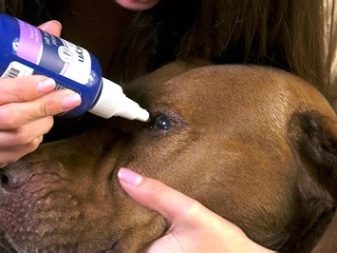
If more serious problems arise, such as curvature of the eyelids or suppuration, do not delay the visit to the veterinarian.
If your pet does not often walk in nature, but mainly in an asphalted yard, then its claws will not grind down enough. In this case, the owner needs to trim them himself. You can easily find accessories for clipping nails at the pet store.
These energetic and cheerful dogs require physical activity. If you don’t play with him, he may find something to do that you don’t like at all.
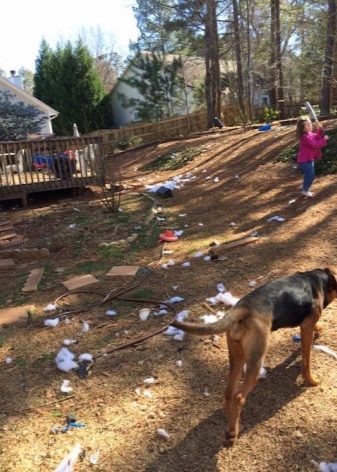

Play outdoor games with him, and to make them more interesting, buy toys at the pet store. It can be a pulling, "plate", ball or other valuable acquisitions.
With age, dogs of this breed may have problems with the musculoskeletal system, and most often the cause of this specific ailment is the excessive weight of the tailed gluttons.
It is difficult for a dog to carry it, and with an insufficiently active lifestyle and overeating, it is at risk of obesity. Prevention of any disease is a balanced diet, which enriches the dog's body with essential vitamins and minerals, prevents it from gaining extra pounds, but allows it to get a boost of energy.

Especially important control the nutrition of the puppy, because by doing so you are laying the foundation for his health for years to come. For detailed, practical advice on feeding your four-legged friend, see your veterinarian - he will offer you a healthy diet for every day.
Often these dogs are actively drooling.
This process is inevitable due to the structure of the face and body of bloodhounds. If you do not want to wipe them off the dog's face, and this feature of this breed annoys you, then do not start such a dog at all.
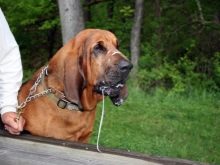
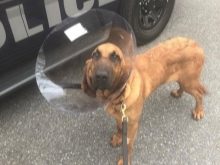
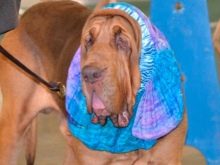
For a good and loving owner, this issue is easily resolved. Have wipes ready for cleaning the dog's face, and then this phenomenon will not be a problem.
Education and training
It is possible to raise a harmoniously developed dog from a puppy only in one case: you have to be patient and devote enough time to the learning process. As noted, the physical force applied to these proud and self-willed hunters does not bring positive results.
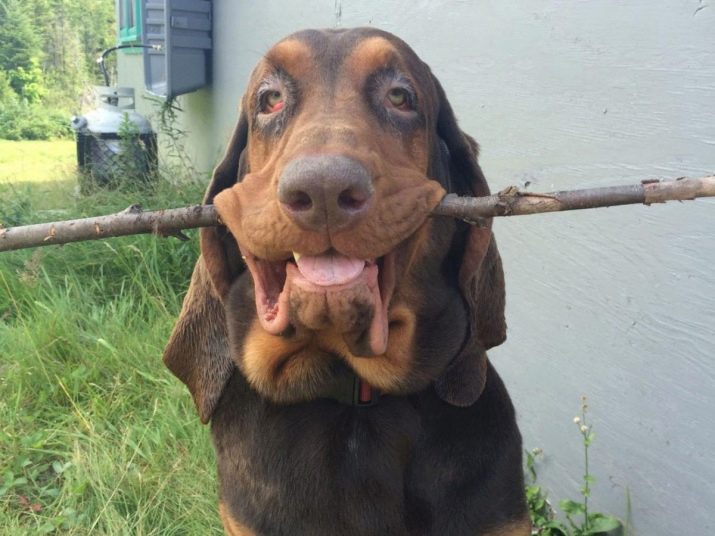
Apparently, the Bloodhound feels his noble origin, and therefore is in no hurry to serve the owner.
Some owners of these dogs are even of the opinion that these dogs cannot be ordered - they must be asked.
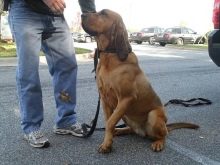
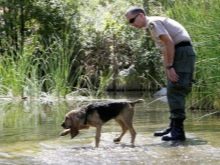
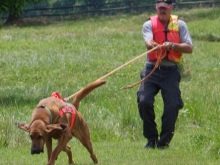
It is up to you to decide which tactics to choose when dealing with these dogs, but it will still be useful to familiarize yourself with the advice of the experts.
- Do not spend more than 15 minutes practicing commands, it will tire the dog.
- Each time, end the lesson on a positive moment when the dog has followed a command and received a reward in the form of a treat. This will reinforce her positive reflex.
- If the life of your blood is boring and monotonous, you don’t take it to parks or other busy places, don’t play with it, then damage to furniture in the house is inevitable. Try to organize leisure activities that will fill his life with impressions. Toys are not that expensive, and you can always arrange for him to "find things".
Mating season
During estrus, the dog needs special supervision. If offspring are not part of your plans, keep it tightly on a leash while walking.
During the period of a rampage of hormones, the dog becomes uncontrollable and can simply run away from the owner, even if it was usually always obedient and obeying commands.
If the female lives in the local area, then during this period, keep her in a closed aviary.
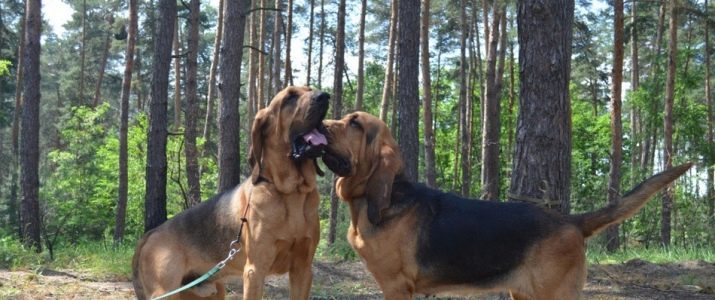
The most successful days for a romantic date are 11-15.
Despite the readiness of the dog to meet the male in the first heat, it is not recommended to do this - it is better to wait until the age of two years.
As for males, early mating is no less harmful for them. So a couple is unlikely to have good offspring, and they themselves can undermine the health of both the reproductive system and the whole organism. Before the X-hour, the dogs need to be walked well, but they should not be fed.
To begin with, they need to be taken to neutral territory, where they can get to know each other and play, and after such a "prelude" the couple must be taken to the dog.

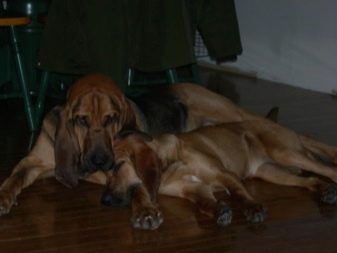
If they try to start the process already during the acquaintance, then they should not be disturbed.
Prices for puppies
It just so happened historically that this breed is not very popular in our country, so getting a puppy can be problematic. You can buy a baby for the soul without the prospect of exhibiting for 30-40 thousand rubles. A breed-class dog that is allowed to compete and breed will cost about twice as much. However, these puppies will not have a high enough rating to win.
The most titled dogs, which descended from champions, will cost about 100 thousand rubles.
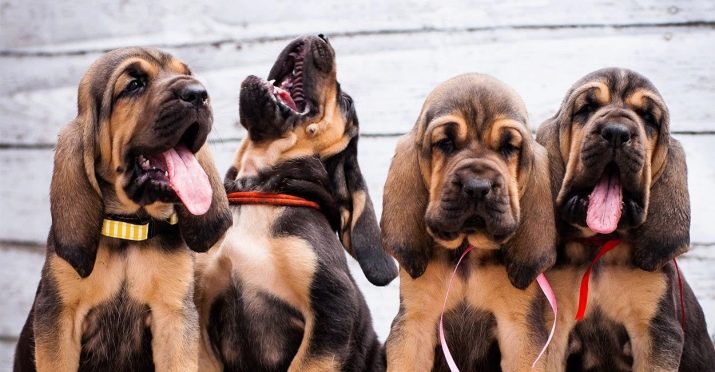
Bloodhounds are natural born hunters and this cannot be taken away from them.
A thoroughbred dog not only adds prestige to its owner, it needs high-quality feeding and an adequate regimen with regular exercise and play.
And in the case of this breed, he will always look for something and poke his curious nose into all your affairs. If you are ready to get this smart and kind, but proud dog, then contact specialized breeders. Your new family member will certainly conquer all household members and become a true friend for them.
A film about the Bloodhound breed can be viewed below.






































